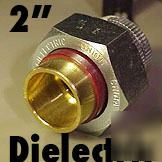Kenosha Reuse Discussion Board > GURNEE, IL
> Commercial
> Industrial
> New 2" dielectric union fip x swt 3001A-2 coupler; $25
New 2" dielectric union fip x swt 3001A-2 coupler; $25
NEW 2" Dielectric Union FIP x SWT # 3001A-2"
(Xreferences: Grainger Item # 1A538; WATTS # 001A1QUOT
Dielectric Union, Size 2 x 2 In, FIP x Solder Connection, Material of Construction Malleable Iron x Brass, Pressure Rating 250 PSI, Max Temp 180 F, Standards Meets Federal Specifications For Tensile Strength And Thread End Connections.
One common use: Water Heater Repair
For use wherever dissimilar metals are used in a piping system. Prevents pipe deterioration from corrosion due to galvanic and stray currents.
Rating: 250 PSI, 180 degrees F maximum
This device electrically separates the water heater from the household piping.
It also provides a convenient way to disconnect the piping for removal or servicing of an appliance, such as a water heater or water softener.
Components Of A Dielectric Union:
The big nut clamps the brass part to the steel threaded part.
The black washer and purple insulator keep the brass and steel parts from touching.
The brass part gets soldered to a copper pipe.
The steel part is threaded onto a piece of steel pipe.
Why is all this complicated plumbing necessary?
If you recall from high school chemistry, two dissimilar (different) metals, when placed in an acidic solution, will create a battery. And one metal will usually erode away as the chemical reaction progresses. The other metal may have a buildup of new material, which may be a chemical combination of the eroded metal and the acid. Since virtually all domestic water is slightly acidic or slightly basic, this electro-galvanic action can occur in any metal plumbing system.
When copper and steel pipes are connected together directly, the "battery" has a path for electrical current to flow. (This current is tiny, and the voltage is not a safety hazard.)
If the current cannot flow, because there is no electrical connection (interrupted by the plastic insulators) then the "battery" never discharges. In theory there will always be a small voltage between the different metals. The metals do not erode.
Installing The Dielectric Union:
1. I used a pipe wrench to install the threaded end of the dielectric union.
2. Then I took the union apart and put a piece of copper pipe in the brass part, and soldered the joint.
3. I did the soldering on a workbench, using a piece of galvanized sheet metal (a scrap from an old section of heating duct) as a heat shield.
4. After the joint cooled down, I put the plastic insulator on the brass part, followed by the steel nut.
5. The dielectric union was then ready to use. I soldered the next fitting (in this case an adapter fitting for connecting to a threaded pipe) onto the other end of the pipe.
7. The union was assembled, using a big 15" adjustable wrench. A large pair of "Channel Lock" pliers also works for tightening the nut.
http:// /archives/plumbing/heating/dom_water/connect.html
- This item may have been opened for inspection but is new, Guaranteed!.
so please inform your friends of our great deals!

